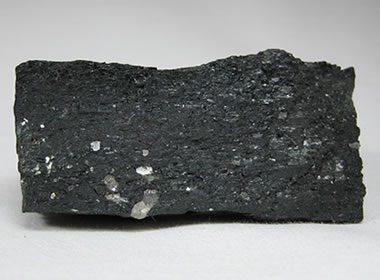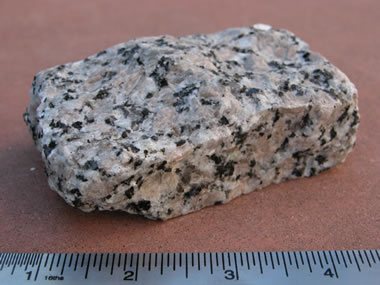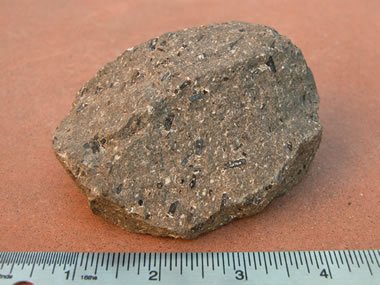Home » Minerals » Hornblende
Hornblende
A common rock-forming mineral found in igneous and metamorphic rocks

Hornblende: Hornblende with a typical black granular to fibrous appearance from Faraday Township, Ontario, Canada. This specimen is approximately 3 inches (7.6 centimeters) across.
What is Hornblende?
Hornblende is a field and classroom name used for a group of dark-colored amphibole minerals found in many types of igneous and metamorphic rocks. These minerals vary in chemical composition but are all double-chain inosilicates with very similar physical properties. A generalized composition for the hornblende group is shown below.
(Ca,Na)2-3(Mg,Fe,Al)5(Si,Al)8O22(OH,F)2
Note that calcium, sodium, magnesium, iron, aluminum, silicon, fluorine and hydroxyl can all vary in abundance. This creates a huge number of compositional variants.
Chromium, titanium, nickel, manganese, and potassium can also be part of the complex composition and further indicates the generalization of the formula given above.

Biotite hornblende granite: Hornblende is an important constituent in many igneous rocks. This piece of biotite hornblende granite is an example. Image by NASA.
Hornblende Minerals
As noted above, hornblende is a name used for a number of dark-colored amphibole minerals that are compositional variants with similar physical properties. These minerals cannot be distinguished from one another without laboratory analysis. A small list of the hornblende minerals is given below with their chemical compositions.
| Mineral |
Chemical Composition |
| Edenite |
Ca2NaMg5(AlSi7)O22(OH)2 |
| Ferro-actinolite |
Ca2(Fe,Mg5)(Si8O22(OH)2 |
| Ferro-edenite |
Ca2NaFe5(AlSi7)O22(OH)2 |
| Ferro-pargasite |
Ca2NaFe4Al(Al2Si6)O22(OH)2 |
| Ferro-tschermakite |
Ca2Fe3Al2(Al2Si6)O22(OH)2 |
| Glaucophane |
Na2Mg3Al2Si8O22(OH)2 |
| Kaersutite |
Ca2Na(Fe,Mg)4Ti(Al2Si6O22(OH)2 |
| Pargasite |
Ca2NaMg4Al(Al2Si6)O22(OH)2 |
| Tremolite |
Ca2(Mg,Fe5)(Si8O22(OH)2 |
| Tschermakite |
Ca2Mg3Al2(Al2Si6)O22(OH)2 |

Hornblende Andesite: Hornblende is an important constituent in many igneous rocks. In extrusive rocks, hornblende sometimes crystallizes below the ground, in the magma, before eruption. That can produce large phenocrysts of hornblende in a fine-grained rock. This piece of hornblende andesite is an example. Image by NASA.
Hornblende as a Rock-Forming Mineral
Hornblende is a rock-forming mineral that is an important constituent in acidic and intermediate igneous rocks such as granite, diorite, syenite, andesite, and rhyolite. It is also found in metamorphic rocks such as gneiss and schist.
A few rocks consist almost entirely of hornblende. Amphibolite is the name given to metamorphic rocks that are mainly composed of amphibole minerals. Lamprophyre is an igneous rock that is mainly composed of amphibole and biotite with a feldspar ground mass.
Physical Properties of Hornblende |
| Chemical Classification |
Silicate |
| Color |
Usually black, dark green, dark brown |
| Streak |
White, colorless - (brittle, often leaves cleavage debris behind instead of a streak) |
| Luster |
Vitreous |
| Diaphaneity |
Translucent to nearly opaque |
| Cleavage |
Two directions intersecting at 124 and 56 degrees |
| Mohs Hardness |
5 to 6 |
| Specific Gravity |
2.9 to 3.5 (varies depending upon composition) |
| Diagnostic Properties |
Cleavage, color, elongate habit |
| Chemical Composition |
(Ca,Na)2–3(Mg,Fe,Al)5(Al,Si)8O22(OH,F)2 |
| Crystal System |
Monoclinic |
| Uses |
Very little industrial use |
Identification of Hornblende
Hornblende minerals as a group are relatively easy to identify. The diagnostic properties are their dark color (usually black) and two directions of excellent cleavage that intersect at 124 and 56 degrees. The angle between the cleavage planes and hornblende's elongate habit can be used to distinguish it from augite and other pyroxene minerals that have a short blocky habit and cleavage angles intersecting at about 90 degrees. The presence of cleavage can be used to distinguish it from black tourmaline that often occurs in the same rocks.
Identifying the individual members of the hornblende group is difficult to impossible unless a person has the skills and equipment to do optical mineralogy, x-ray diffraction, or elemental analysis. The introductory student or the beginning mineral collector can be satisfied to assign the name of "hornblende" to a specimen.

The best way to learn about minerals is to study with a collection of small specimens that you can handle, examine, and observe their properties. Inexpensive mineral collections are available in the Geology.com Store. Image copyright iStockphoto / Anna Usova.
Uses of Hornblende
The mineral hornblende has very few uses. Its primary use might be as a mineral specimen. However, hornblende is the most abundant mineral in a rock known as amphibolite which has a large number of uses. It is crushed and used for highway construction and as railroad ballast. It is cut for use as
dimension stone. The highest quality pieces are cut, polished, and sold under the name "black granite" for use as building facing, floor tiles, countertops, and other architectural uses.
Hornblende has been used to estimate the depth of crystallization of plutonic rocks. Those with low aluminum content are associated with shallow depths of crystallization, while those with higher aluminum content are associated with greater depths of crystallization. This information is useful in understanding the crystallization of magma and also useful for mineral exploration. [1]

Find Other Topics on Geology.com:
 | Rocks: Galleries of igneous, sedimentary and metamorphic rock photos with descriptions. |
|
 | Minerals: Information about ore minerals, gem materials and rock-forming minerals. |
|
 | Volcanoes: Articles about volcanoes, volcanic hazards and eruptions past and present. |
|
 | Gemstones: Colorful images and articles about diamonds and colored stones. |
|
 | General Geology: Articles about geysers, maars, deltas, rifts, salt domes, water, and much more! |
|
 | Geology Store: Hammers, field bags, hand lenses, maps, books, hardness picks, gold pans. |
|

|
 | Diamonds: Learn about the properties of diamond, its many uses, and diamond discoveries.
|
|





















